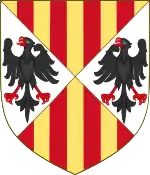Elisabeth of Sicily, Duchess of Bavaria
Elisabeth of Sicily (1310–1349) was a daughter of Frederick III of Sicily and Eleanor of Anjou. Her siblings included: Peter II of Sicily and Manfred of Athens. After her death her title was given to Georgia Lanza.
Elisabeth of Sicily | |
|---|---|
 Coat-of-arms of the kingdom of Sicily | |
| Born | 1310 |
| Died | 21 March 1349 Landshut |
| Noble family | House of Barcelona |
| Spouse(s) | Stephen II, Duke of Bavaria |
| Issue | Stephen III, Duke of Bavaria Frederick, Duke of Bavaria John II, Duke of Bavaria Agnes, Queen of Cyprus |
| Father | Frederick III of Sicily |
| Mother | Eleanor of Anjou |
Marriage and issue
On June 27, 1328, Elisabeth married Stephen II, Duke of Bavaria,[1] son of Louis IV, Holy Roman Emperor and Beatrix of Silesia-Glogau. The couple had three sons and a daughter, they were:
- Stephen III of Bavaria-Ingolstadt (1337–September 26, 1413, Niederschönfeld).
- Frederick of Bavaria-Landshut (1339–December 4, 1393, Budweis).
- John II of Bavaria-Munich (1341–1397), married Katharina of Görz[2]
- Agnes (b. 1338), married c. 1356 King James I of Cyprus.
Elisabeth died in 1349, her husband later married Margarete of Nuremberg; they had no children.
Descendants
Two of her sons became Dukes of Bavaria and her daughter, Agnes, became Queen of Cyprus by her marriage to James I of Cyprus. Her granddaughter and namesake was Isabeau of Bavaria, queen of France by her marriage to Charles VI of France. Isabeau's children included: Isabella, Queen of England; Catherine, also queen of England; Michelle, duchess of Burgundy and Charles VII of France.
References
- Dahlem 2012, p. 251.
- Thomas 2010, p. 387.
Sources
- Dahlem, Andreas (2012). "Late Fifteenth Century Architectural Manifestations of Ducal Authority in the Vicinity of Munich". In Anderson, Emily-Jan; Farquhar, Jill; Richards, John (eds.). Visible Exports / Imports: New Research on Medieval and Renaissance European Art and Culture. Cambridge Scholars Publishing. p. 239-260.
- Thomas, Andrew L. (2010). A House Divided: Wittelsbach Confessional Court Cultures in the Holy Roman Empire, c.1550-1650. Brill.